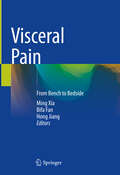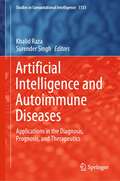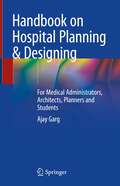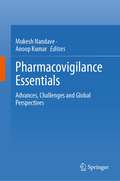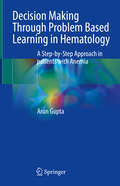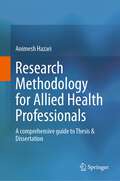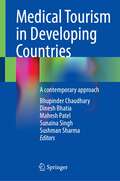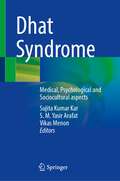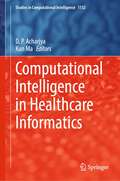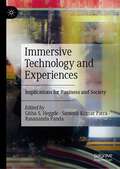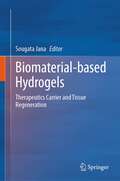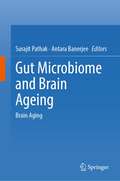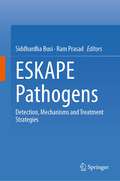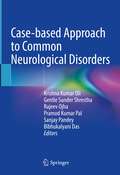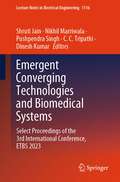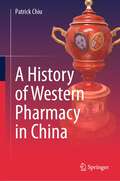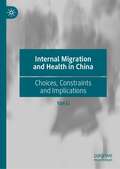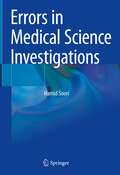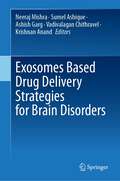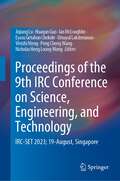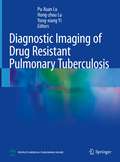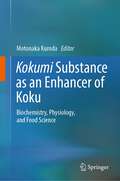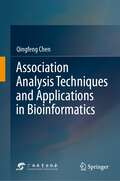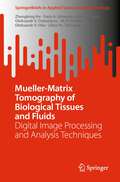- Table View
- List View
Visceral Pain: From Bench to Bedside
by Hong Jiang Ming Xia Bifa FanPatients with chronic visceral pain present a challenge for medical providers because of their vague presenting symptoms and frequent lack of identifiable pathology. Despite this, chronic visceral pain can be a debilitating medical condition that increases morbidity and decreases quality of life; the long-term consequences of which cause significant socioeconomic burden and debility. Covering the newest trends, studies, diagnosis and treatments in visceral pain care, as well as the pain treatment strategies that have been successfully employed in the past, this book brings readers fully up to date with effective recognitions and treatments for visceral pain. The clinical evaluation and presentation of common chronic visceral pain conditions and multimodal treatment options that can be used to assist patients and providers are focused.
Artificial Intelligence and Autoimmune Diseases: Applications in the Diagnosis, Prognosis, and Therapeutics (Studies in Computational Intelligence #1133)
by Khalid Raza Surender SinghThe book provides an overview of various autoimmune disorders and how artificial intelligence (AI) and machine learning will be used for the diagnosis, prognosis, and treatment of these disorders. AI algorithms are used to create synthetic patient populations with the properties of actual patient cohorts, build personalized predictive models of drug combinations and unravel complex relationships between diet, microbiome, and genetic line-up to determine the comparative treatment response. The book highlights clinical applications and challenges of AI for the diagnosis and treatment/management of autoimmune disorders which includes Rheumatoid Arthritis (RA), Multiple Sclerosis (MS), Type I Diabetes, Psoriatic Arthritis (PsA), and other critical diseases.
Handbook on Hospital Planning & Designing: For Medical Administrators, Architects, Planners and Students
by Ajay GargThis handbook is in reference to the book "Manual of Hospital Planning and Designing" which was earlier published by Springer Nature.This "Handbook on Hospital Planning and Designing" is a helpful guide that shows how to build an efficient healthcare project. Carefully planning and designing hospitals is essential to deliver and effective healthcare facilities. It's basically a mix of art, science, and caring. This book highlights the rooms, spaces, MEP service, safety, security, equipment, instruments, and other support services.This book is a summary of the essentials for designers and planners who want to design hospitals. Architects, designers, doctors, and people who are involved in the designing of hospital, will find it useful. It helps them make places that work well, look nice, and care for patients best. Setting up the hospital project is more than just building. It's about creating places where people get better and feel good.This book explores everything about planning and designing hospitals in the given chapters from the beginning, covering all the departments until the hospital is all set up. This book is helpful for experienced architects with new ideas, a healthcare worker who wants the best for patients, or a student who loves learning about hospitals.
Pharmacovigilance Essentials: Advances, Challenges and Global Perspectives
by Mukesh Nandave Anoop KumarThe book explores the field of pharmacovigilance, its historical context, along with its critical role in ensuring the safety of medications across the world. From its foundational principles to cutting-edge advancements and future challenges, this book provides a thorough understanding of the field's intricacies. The book begins by establishing the fundamentals of pharmacovigilance, emphasizing its significance in monitoring, detecting, assessing, and preventing adverse drug reactions (ADRs) that occur during the use of medications. Delving into the history of pharmacovigilance and regulatory actions, the book traces the evolution of the field, highlighting significant milestones and the establishment of regulatory frameworks that govern medication safety. It explores the pivotal role of regulatory authorities in developing guidelines, regulations, and policies to safeguard public health. A significant aspect covered in the book is the processing of ADRs, providing insights into the steps involved in handling and evaluating ADR reports. The book also addresses specialized areas within pharmacovigilance, including vaccine safety surveillance, herbovigilance (monitoring the safety of herbal medicines), materiovigilance (monitoring the safety of medical devices), and hemovigilance (ensuring the safety of blood products). Additionally, the book explores the role of pharmacogenetics in pharmacovigilance, highlighting how genetic factors influence individual responses to medications and how this knowledge can be integrated into safety monitoring and risk assessment. This book also covers databases used in pharmacovigilance across the globe, aggregate reporting and pharmacovigilance systems in EU and non-EU countries, and the role of artificial intelligence.Finally, it emphasizes the need for continuous improvement, vigilance, and proactive measures to adapt to the changing healthcare landscape and address emerging safety concerns. The book serves as acomprehensive guide for healthcare professionals, researchers, regulators, and policymakers involved in pharmacovigilance.
Decision Making Through Problem Based Learning in Hematology: A Step-by-Step Approach in patients with Anemia
by Arun GuptaIn this era of teaching through problem-based learning, this unique book guides approaching patients with anemia through a step-by-step analysis of test results. It explains the rationale for requesting appropriate tests and analyzing them systematically and correlates each answer to the disease-based entity on the latest evidence. The target audience is undergraduate medical students during hematopathology training and the introductory phase in clinical Medicine and Hematology, postgraduate residents in Hematology and Medicine, and undergraduate and postgraduate Allied Health students. It provides a quick reference source for practitioners and teachers in medical and paramedical institutions. Question-answer format for quick review before exams. Hundreds of visual illustrations with microscopic images and tables.Quick reference for students in wards and clinics.
Research Methodology for Allied Health Professionals: A comprehensive guide to Thesis & Dissertation
by Animesh HazariResearch Methodology is one of the essential subjects for Master's and Ph.D. students, which requires a comprehensive understanding of the subjects with their scientific application. This book would target all aspects, including detailed information on components of research methodology, to enable readers to conduct and write their research work. Thus, the book covers a larger audience in the allied health stream, focusing on university students and Ph.D. scholars. The language of the book is simple and lucid, with multiple illustrations for easy understanding. Ultimately the book would aim to prepare competitive health professionals to render the highest quality of research work and enable them to transform it into their clinical practice. With years of vast experience and research output, the project will have a great success and fruitful outcome.
Medical Tourism in Developing Countries: A contemporary approach
by Bhupinder Chaudhary Dinesh Bhatia Mahesh Patel Sunaina Singh Sushman SharmaThis book provides a detailed insight into the amalgamation of the healthcare and hospitality sector, which brought forward the concept of healthcare tourism or medical tourism. There have not been comprehensive resources in this particular area. The available quality resources focus on the Western world. Countries like India are an upcoming and one of the most favored destinations for medical tourism, and this trend is going to increase exponentially in the coming years. This book is developed in a very simple and lucid manner to enable even a layman to grasp the key components of the healthcare and hospitality sector at different levels and gradually link it to the present scenario where factors like accreditation, health insurance, corporatization, and public policy make an impact. Scholars in these sectors attempt to provide the recent trends and prospects supported with updated information. Therefore, it can solve the problem of a single source of detailed information relevant to different yet interconnected industries with a focus on developing countries.
Dhat Syndrome: Medical, Psychological and Sociocultural aspects
by Sujita Kumar Kar S. M. Yasir Arafat Vikas MenonDhat Syndrome is known as a culture-bound syndrome in South Asia. People with Dhat Syndrome often present with anxiety and distress related to semen loss. Multiple somatic and sexual symptoms often accompany this. The symptoms of Dhat Syndrome closely resemble other neurotic and stress-related disorders. Myths related to sexuality are often the core phenomenon in dhat syndrome, which is responsible for the generation of psychopathology—addressing the myth's preliminary results in resolving psychopathology. However, many patients require pharmacological and psychological management. Due to strong cultural beliefs and associated myths, patients with Dhat Syndrome often reach out to traditional healers before getting the proper psychiatric consultation, further consolidating their myths and poor attitude toward treatment. However, Dhat Syndrome resembles a male entity; a similar entity is reported in females, where females attribute their non-pathological vaginal discharge to psychological distress. The pattern of symptoms has a significant resemblance with Dhat Syndrome in males. There is no standard book that exclusively discusses various aspects of Dhat Syndrome. This book examines the evolution of Dhat Syndrome to the current understanding of the disease and its management. Hence, this book will be unique and helpful for this disorder.
Computational Intelligence in Healthcare Informatics (Studies in Computational Intelligence #1132)
by D. P. Acharjya Kun MaThe book presents advancements in computational intelligence in perception with healthcare applications. Besides, the concepts, theory, and applications in various domains of healthcare systems including decision making in healthcare management, disease diagnosis, and electronic health records will be presented in a lucid manner. To achieve these objectives, both theoretical advances and its applications to healthcare problems will be stressed upon. This has been done to make the edited book more flexible and to stimulate further research interest in topics. The book is divided into four sections such as theoretical foundation of computational intelligence techniques, computational intelligence in analyzing health data, computational intelligence in electronic health record (EHR), and computational intelligence in ethical issues in health care.
Immersive Technology and Experiences: Implications for Business and Society
by Githa S. Heggde Santosh Kumar Patra Rasananda PandaThis book provides a comprehensive overview of the role of immersive technology with multiple sectoral perspectives, such as entertainment, education, health care, and more. It covers a detailed analysis of the latest trends and developments in the field. It encompasses practical insights on using immersive technology effectively through industry expert chapters, case studies, and real-world examples that demonstrate how immersive technology is being used in different industries. Chapters in this book are from academicians and industry professionals to create a fine balance of knowledge and practice perspective of today’s immersive technology. It is written in accessible language that is easy for non-experts to understand. It focuses on the future of immersive technology, exploring its potential impact on society and the economy. It provides insights into the challenges and opportunities that lie ahead and offers predictions on how immersive technology will continue to evolve in the years to come. It is a valuable resource for anyone learning more about immersive technology.
Biomaterial-based Hydrogels: Therapeutics Carrier and Tissue Regeneration
by Sougata JanaThis book highlights recent advances in natural and synthetic biomaterials-based hydrogel for drug delivery carriers and tissue engineering. It covers key topics such as chitosan, alginate, gelatin, cyclodextrin, cellulose, starch, hyaluronic acid, dextran, collagen hydrogel, Injectable hydrogel magnetic hydrogel, DNA-based hydrogels, 3D printing of hydrogels, hydrogel for bone tissue engineering and regenerative medicine, etc. Each chapter develops a particular aspect of recent advances in biomaterial-based Hydrogels delivery systems to cover the importance, fabrication technology, characterization, evaluation, delivery of therapeutic and biomedical applications, and future perspectives. Written by a group of renowned scientists, chemists, biologists, and engineers from around the world, the book is designed as an important reference resource for scientists and researchers working on advanced biomaterials in the fields of pharmaceuticals, biomedical science, biomedical engineering,nanotechnology, and material science for most updated findings and future research trends.
Gut Microbiome and Brain Ageing: Brain Aging
by Surajit Pathak Antara BanerjeeThis book, Gut microbiome and Brain Ageing, deals with the mechanisms and phenomenon that relates gut microbiome and aging of the brain. This book will bring forth the connection between good gut and brain aging and includes some cutting edge research topics dealing with gut physiology and its importance as future therapeutic option in neurological disorders. The gut microbiome's impact on neuronal function, mediated by neurotransmitters, vitamins, and neuroactive microbial metabolites, is an exciting area of investigation that this book thoroughly explores. It also covers the pivotal role of the gut microbiome in the etiology of various neurodegenerative disorders such as Alzheimer’s disease (AD), Parkinson’s disease (PD), depression, or multiple sclerosis (MS). It also explores the expanding understanding of the importance of the early-life gut microbiota and its implications for long-term health consequences. This book primarily addresses researchers, clinicians, and doctoral andgraduate students working in biomedicine, neurobiology, nutrition, microbiology, and translational medicine streams.
ESKAPE Pathogens: Detection, Mechanisms and Treatment Strategies
by Siddhardha Busi Ram PrasadThis book explores the medical importance of Enterococcus faecium, Staphylococcus aureus, Klebsiella pneumoniae, Acinetobacter baumannii, Pseudomonas aeruginosa, and Enterobacter spp. (ESKAPE) pathogens, and the challenges posed by antibiotic resistance. It covers the antibiotic resistance profile and detection of ESKAPE pathogens, as well as the mechanistic understanding of antibiotic resistance in these pathogens. The book discusses standard microbiological techniques, including staining, morphological and cultural characteristics, biochemical properties, and serotyping, as well as nucleic acid amplification and molecular diagnostic techniques for the detection of ESKAPE pathogens. In addition, the book explores biochemical, molecular, and computational techniques for the determination of virulence factors of ESKAPE pathogens. It also examines the synthesis, structure, function, and inhibitors of virulence factors and biofilm componentsin these pathogens. The book explores various strategies for combating ESKAPE pathogens, including antibiotic adjuvants and their synergistic activity, phytochemicals as potential antibacterial agents, photodynamic therapy, antimicrobial peptides and antibacterial antibodies, antimicrobial activity of Nanomaterials and Nanocomposites, and bacteriophage therapy. Finally, the book discusses in silico and computational approaches for the inhibition of ESKAPE pathogens. This comprehensive book is of interest to researchers, students, and healthcare professionals interested in the diagnosis, prevention, and treatment of ESKAPE pathogens.
Case-based Approach to Common Neurological Disorders
by Krishna Kumar Oli Gentle Sunder Shrestha Rajeev Ojha Pramod Kumar Pal Sanjay Pandey Bibhukalyani DasThis book primarily aims to assists doctors from non-neuroscience background to acquire knowledge about common neurological disorders encountered in a resource-constrained setup in a case-based and practical approach. The book elucidates the value of proper and systematic approach to the patient, how proper history taking and clinical evaluation, followed by appropriate investigations can narrow down the differential diagnoses and help proper and timely management of the patients.The book covers most of the common neurological disorders and scenarios encountered in clinical practice and will benefit clinicians facing difficult cases, particularly those involving fundamental research and diagnostic methods. This book is useful for physicians working in internal medicine, physicians handling neurology cases in resource-constrained facilities, and fellows in neurology. The contents of this book support and practically enhance the knowledge acquiredfrom other text books.
Emergent Converging Technologies and Biomedical Systems: Select Proceedings of the 3rd International Conference, ETBS 2023 (Lecture Notes in Electrical Engineering #1116)
by Shruti Jain Nikhil Marriwala Pushpendra Singh C. C. Tripathi Dinesh KumarThe book contains proceedings of the International Conference on Emergent Converging Technologies and Biomedical Systems ETBS 2023. It includes papers on wireless multimedia networks, green wireless networks, electric vehicles, biomedical signal processing, and instrumentation, wearable sensors for health care monitoring, biomedical imaging, and bio-materials, modeling, and simulation in medicine biomedical, and health informatics. The book serves as a useful guide for educators, researchers, and developers working in the areas of signal processing, imaging, computing, instrumentation, artificial intelligence, and their related applications. This book also provides support and aid to the researchers involved in designing the latest advancements in healthcare technologies.
A History of Western Pharmacy in China
by Patrick Chiu“This book represents an important contribution to the field as it is the first to provide a detailed account of the interaction between Chinese and western medicine from a pharmacy perspective over a period of two millennia with an emphasis on the modern period from 1800-1949. None of the existing historiography on the relationship between TCM and western medicine has so far explored pharmaceutical aspects in detail. This book therefore fills an important gap in the literature and is likely to become a key resource for further study. It will be of interest to a wide audience, including pharmaceutical, imperial, and business historians, and should be essential reading for pharmacy students. But it will also be of interest to a general readership curious about the history of pharmacy in China and of western influences on Chinese medicine. Stuart Anderson, BSc, MA, PhD, FRPharmS Editor-in-Chef, Pharmaceutical Historian, Emeritus Professor of Pharmacy History, London School of Hygiene & Tropical Medicine “Readers of this book, to Chiu’s credit, will be exposed to the nuanced cultural, medico-scientific, and business interactions that shaped Western pharmacy in China. Chiu puts a spotlight on the various materials, techniques, and processes of drug formulation and mass manufacture – and he rightly illustrates how pharmacy was substantiated as big business and mass manufacture. In analyses that incorporate materia medica and so-called dangerous drugs, such as opium, Chiu also articulates the complicated entangled histories of the movement, circulation, and translation of both pharmacy knowledge and goods. Yet, he appropriately acknowledges and evaluates non-Western epistemologies and practices that intermingled with Western ideas to create a novel type of pharmacy and pharmaceutical industry in China. Lucas Richert, PhD Professor & George Urdang Chair in Pharmacy History, UW-Madison Executive Director, American Institute of the History of Pharmacy”Patrick Chiu's book, A History of Western Pharmacy in China, effectively presents an unbiased perspective when discussing the contributions of expatriate pharmacy academics towards the development of China's pharmaceutical profession and the modern drug industry in the first half of the twentieth century. Chiu's impartial approach and well-researched content make it a recommended resource for understanding the historical development of pharmacy in China. Kazushige Morimoto Ph.D. D.Min, Education System - Qualified Pharmacist, President, The Japanese Society for the History of Pharmacy
Internal Migration and Health in China: Choices, Constraints and Implications
by Yan LiThis book focuses on the multifaceted reality of social and health constraints and health services access among migrants in China, by originally exploring the social strata, social networks, and the understanding of health and health services among migrants. Furthermore, this book investigates the health constraints and health services access of rural-urban migrants in the absence of equal social protection by the government. It argues that the main obstacles to access health services are not only the shortage of financial resources among rural-urban migrants, but also lie in the institutional blindness regarding health security provision, rural-urban dualism and the household registration system in China. The book highlights the key function that social networks play in health and health services access among migrants in China, which has rarely been discussed in previous studies. And it also discusses the understanding of health among migrants, and further analyses that although many migrants have not formed proper understanding of the connotation of health and have limited knowledge of health, prime responsibility should not be put on the migrants because their poor understanding of health mainly results from their rural perspective while health and health services access depend on the social-economic environment in which they live and work.This book would be of interest to people in migration studies, social exclusion and social welfare studies and to people interested in rural-urban migration and health in China.
Errors in Medical Science Investigations
by Hamid SooriThis book introduces all common errors in medical science fields and the ways to control them. Systematic errors could be controlled both during study design and statistical analysis. Some errors have been presented in small segments but not in a comprehensive book. It covers many common errors that usually affect the research proposals, final reports, theses, and scientific presentations in the field of medical sciences as well as the rejection reasons on scientific papers. It will help researchers to control common errors using epidemiological and statistical methods.
Exosomes Based Drug Delivery Strategies for Brain Disorders
by Neeraj Mishra Sumel Ashique Ashish Garg Vadivalagan Chithravel Krishnan AnandThis book provides a comprehensive overview of the role of exosomes in brain diseases, including stroke, multiple sclerosis, Parkinson's disease, Alzheimer's disease, epilepsy, and depression. It covers the basics of exosome biogenesis, composition, and synthesis, as well as the therapeutic potential of exosomes in brain disorders. The correlation between exosomes and neuroinflammation, the challenges of using exosomes as a novel carrier, and engineered exosomes to deliver therapeutic protein are covered well in this book. Use of radiolabelled exosomes as a diagnostic tool and the toxicity studies of exosomes with potential overcome approaches. It is an essential resource for researchers, clinicians, and healthcare professionals working in the field of exosome research, especially on its applications in brain disorders.
Proceedings of the 9th IRC Conference on Science, Engineering, and Technology: IRC-SET 2023; 19-August, Singapore
by Jiqiang Lu Huaqun Guo Ian McLoughlin Eyasu Getahun Chekole Umayal Lakshmanan Weizhi Meng Peng Cheng Wang Nicholas Heng Loong WongThis book highlights the contemporary state of research in multidisciplinary areas of Computer Science, Computer Engineering, Data Science, Electrical and Electronics Engineering, Chemical Engineering, Mechanical Engineering, Physics, Biomedical Sciences, Life Sciences, Medicine, Healthcare, and Business Technology. The accepted submissions to the 9th IRC Conference on Science, Engineering and Technology (IRC-SET 2023) presented on 19 August 2023 are published in this conference proceedings. The papers presented here were shortlisted after extensive rounds of rigorous reviews by a panel of esteemed individuals who are pioneers and experts in their respective domains.
Extracellular Vesicles: From Bench to Bedside
by Qian Wang Lei ZhengThis book aims to provide a comprehensive and systematic understanding of research on extracellular vesicles (EVs). Extracellular vesicles, including exosomes and microvesicles, are nano-sized lipid bilayer encapsulated membranes carrying proteins, lipids, nucleic acids. They are shed by the majority of the cells into the extracellular milieu and present in many biological fluids (blood, urine, saliva, breast milk, cerebrospinal fluid, follicular fluid, semen, lung lavage, and tears). With numerous research publications in recent years, the study of EVs is the emerging field across plenty of disciplines. Many researches and efforts have shown their biogenesis, multiple roles in physiological and pathophysiological processes, and their potential roles as therapeutic agents. The book is organized by outstanding scientists in EV field from the Chinese Society for Extracellular Vesicle (CSEV). It covers the biological basic research of EVs, especially on technologies and methods, as well as the clinical application of EVs as biomarkers for disease diagnosis and therapy.
Diagnostic Imaging of Drug Resistant Pulmonary Tuberculosis
by Pu-Xuan Lu Hong-Zhou Lu Yong-Xiang YiTuberculosis is among the top 10 causes of death worldwide.The WHO clearly proposed that drug-resistant tuberculosis is one of the three major challenge in tuberculosis prevention and control .The book consists of detection of drug-resistant TB and its epidemics, laboratory examination for drug-resistant tubercle bacillus, pathogenic mechanism of drug-resistant TB and its diagnosis, differential diagnosis, treatment, prevention and prognosis of drug-resistant pulmonary TB. This book also focuses on the information of classic cases of drug-resistant TB, including mono-drug-resistant (including Rifampicin resistance, etc.), multidrug-resistant, poly-drug-resistant, extensive-drug-resistant (pre-extensive-drug-resistant), drug-resistant bronchial TB, and pediatric drug-resistant, as well as AIDS complicated with drug-resistant TB, and diagnosis and treatment of drug-resistant cervical TB lymphadenitis. The book also provided a comprehensive description and in-depth analysis for each selected case and a systematic explanation for latest cutting-edge issues, such as dynamic changes in images during the treatment of drug-resistant TB as well as the research and application of artificial intelligence in diagnosing drug-resistant TB, to further inspire our readers. This is a useful book to refer to for respiratory physicians, radiologists, and clinicians in preventive medicine, as well as government officials working in health policies.
Kokumi Substance as an Enhancer of Koku: Biochemistry, Physiology, and Food Science
by Motonaka KurodaThis book provides the basic concepts and latest findings on kokumi substances. It covers not only the topics related to food chemistry, but also the biochemical and physiological mechanisms of the perception of kokumi substances. Food palatability is determined by many factors, including taste, aroma, texture, color, physiological condition, and circumstances. The attribute called “koku” is used in Japan to express delicious foods. The definition of koku attribute was previously proposed to be caused by the sensation of richness, body, lingering (continuity), and mouthfulness in terms of taste, aroma, and texture. Kokumi substance is one of the taste-related koku enhancers and is defined as a substance that enhances complexity, richness (body), and lastingness (continuity), although it has no taste itself at the dose. The topics in this book cover physiological studies, including the receptor mechanism, taste nerve recording, and human brain responses using functional MRI. It also discusses the sensory characteristics of kokumi substances when added to foods and the effect of kokumi substances on the satiety. The intended readers are university students, researchers and technologists in food science, food chemistry, nutritional sciences, taste physiology, and neuroscience. Non-expert readers interested in food palatability and the deliciousness of foods may also find this book useful.
Association Analysis Techniques and Applications in Bioinformatics
by Qingfeng ChenAdvances in experimental technologies have given rise to tremendous amounts of biology data. This not only offers valuable sources of data to help understand biological evolution and functional mechanisms, but also poses challenges for accurate and effective data analysis. This book offers an essential introduction to the theoretical and practical aspects of association analysis, including data pre-processing, data mining methods/algorithms, and tools that are widely applied for computational biology. It covers significant recent advances in the field, both foundational and application-oriented, helping readers understand the basic principles and emerging techniques used to discover interesting association patterns in diverse and heterogeneous biology data, such as structure-function correlations, and complex networks with gene/protein regulation. The main results and approaches are described in an easy-to-follow way and accompanied by sufficientreferences and suggestions for future research. This carefully edited monograph is intended to provide investigators in the fields of data mining, machine learning, artificial intelligence, and bioinformatics with a profound guide to the role of association analysis in computational biology. It is also very useful as a general source of information on association analysis, and as an overall accompanying course book and self-study material for graduate students and researchers in both computer science and bioinformatics.
Mueller-Matrix Tomography of Biological Tissues and Fluids: Digital Image Processing and Analysis Techniques (SpringerBriefs in Applied Sciences and Technology)
by Zhengbing Hu Yuriy A. Ushenko Iryna V. Soltys Oleksandr V. Dubolazov M. P. Gorsky Oleksandr V. Olar Liliya Yu. TrifonyukThis book presents experimental investigations and digital image processing, highlighting the interaction of polarized radiation with phase-inhomogeneous and optically anisotropic biological layers. The promising and efficient use of vector-parametric description of the formation of polarization-inhomogeneous object fields is noted. Applications of a set of Mueller-matrix polarimetry methods are highlighted. The book includes- structural and logical scheme of multi-parameter (singular, interference and layer-by-layer Stokes-polarimetric), polarization-correlation study of the structure of distributions of the number of singularities, maps of local contrast of interference distributions and layer-by-layer maps of microscopic polarization azimuth and ellipticity; determination of relationships between changes in the magnitude of statistical parameters characterizing polarization-correlation distributions and pathology of prostate tumors.
